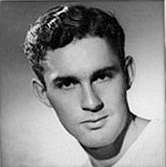Bob Mizer
| Bob Mizer | |
|---|---|
|
Bob Mizer at 20 years old by Bob Mizer Foundation. | |
| Born |
Robert Henry Mizer. March 27, 1922 Hailey, Idaho, United States |
| Died |
May 12, 1992 (aged 70) Los Angeles, California |
| Nationality | American |
| Known for | Photographer, Film director, producer, screenwriter |
| Website | http://www.BobMizerFoundation.org |
Robert Henry Mizer (March 27, 1922 – May 12, 1992), known as Bob Mizer, was an American photographer and filmmaker who was known for pushing societal boundaries in his work. Bob Mizer’s earliest photographs appeared in 1942, in both color and black and white, but his career was catapulted into infamy in 1947 when he was convicted of the unlawful distribution of obscene material through the US mail. The material in question was a series of black and white photographs, taken by Mizer, of young bodybuilders wearing what were known as posing straps — a precursor to the G-string. He would serve a nine-month prison sentence at a work camp in Saugus, California for what now seems tame. At the time, however, the mere suggestion of male nudity was not only frowned upon, but also illegal.
In spite of societal expectations and pressure from law enforcement, Mizer built a veritable empire on his beefcake photographs and films. He established the influential studio, the Athletic Model Guild (AMG) in 1945, but by the time he published the first issue of Physique Pictorial he was operating the studio on his own at his home near downtown Los Angeles. With assistance from his mother, Delia, and his brother, Joe, he photographed thousands of men, building a collection that includes nearly one million different images and thousands of films and videotapes.[1]
Around this time, there were several other photographers doing similar work, such as Alonzo Hanagan in New York City, Douglas of Detroit, Don Whitman of Western Photography Guild in Denver, and, on the West Coast, Russ Warner in Oakland and Dave Martin in San Francisco.
In spite of the trouble that he faced, Mizer continued in the pursuit of his vision, influencing artists like Robert Mapplethorpe and David Hockney.[2] Examples of his work are now held by esteemed educational and cultural institutions the world over, and can be found in various books, galleries, and private art collections. New York University’s 80 Washington Square East Gallery presented what it called "the first major institutional solo presentation of Bob Mizer’s work to be shown anywhere in the world" in early 2014, where artists Bruce Yonemoto, Karen Finley and Vaginal Davis added to NYU's scholarship on Mizer. The New York Times reported that the exhibition "makes a good case for [Mizer] as an artist with interests and imagination considerably more expansive than what his popular reputation suggests."[2]
In 1999, Beefcake, a docu-drama directed by Thom Fitzgerald, was produced, inspired by a picture book by F. Valentine Hooven III (published by Taschen).
Films
Bob Mizer produced over 3,000 film titles from the early 1950s to the early 1980s. In August 1980, he began using the then-new technology of VHS, and recorded over 7500 hours of his photo sessions until his death in 1992.
Partial filmography
- Advice Without Consent (1955)
- Alladin (1956)
- Andy & The Angry Mummy (1963)
- Motorcycle Thief (1958)
- Love 2001 (1970)
- Joe Dallesandro Posing (1966)
- Tijuana Bandit (1964)
References
As of 19 November 2011, this article is derived in whole or in part from Bob Mizer Foundation. The copyright holder has licensed the content in a manner that permits reuse under CC BY-SA 3.0 and GFDL. All relevant terms must be followed. The original text was at "Biography".
- ↑ Hanson, Dian, 2009. Bob's World: The Life and Boys of AMG's Bob Mizer. Köln, Germany]]: Taschen. ISBN 978-3-8365-1230-5, p. 19.
- 1 2 "Beyond Beefcake in the Work of a Gay Pioneer", The New York Times, January 10, 2014
Further reading
- Padva, Gilad. Nostalgic Physique: Displaying Foucauldian Muscles and Celebrating the Male Body in Beefcake. In Padva, Gilad, Queer Nostalgia in Cinema and Pop Culture, pp. 35–57 (Palgrave Macmillan, 2014, ISBN 978-1-137-26633-0).
- Wenger, Daniel (22 September 2016). "The Obsessive Photographer Behind America's First Gay Magazine". The New Yorker.
- Wolf, Kate (2 November 2016). "Beyond the Muscle". East of Borneo.
External links
- Bob Mizer Foundation website
- Athletic Model Guild website
- TASCHEN – Bob's World. The Life and Boys of AMG's Bob Mizer ISBN 3-8365-1230-0
- Exile Gallery Web Site
- New York solo debut of work and objects by Bob Mizer at Invisible-Exports
- Find-a-Grave memorial
